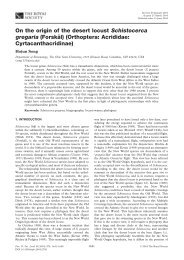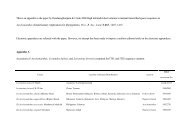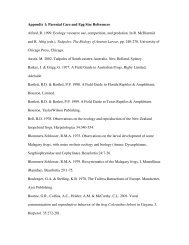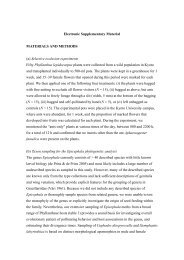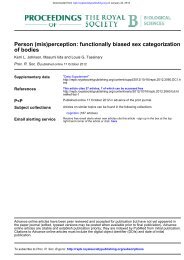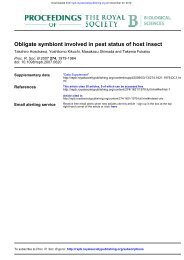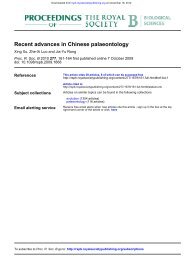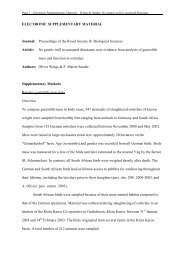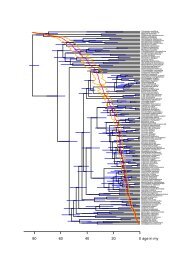Partner choice in Medicago Truncatula– Sinorhizobium symbiosis
Partner choice in Medicago Truncatula– Sinorhizobium symbiosis
Partner choice in Medicago Truncatula– Sinorhizobium symbiosis
You also want an ePaper? Increase the reach of your titles
YUMPU automatically turns print PDFs into web optimized ePapers that Google loves.
<strong>Partner</strong> <strong>choice</strong> <strong>in</strong><br />
<strong>symbiosis</strong><br />
Cécile Gubry-Rang<strong>in</strong>, Marjorie Garcia and Gilles Béna<br />
<strong>Medicago</strong> Truncatula−S<strong>in</strong>orhizobium<br />
Proc. R. Soc. B 2010 277,<br />
1947-1951 first published onl<strong>in</strong>e 3 March 2010<br />
doi: 10.1098/rspb.2009.2072<br />
References<br />
Subject collections<br />
Email alert<strong>in</strong>g service<br />
Downloaded from<br />
rspb.royalsocietypublish<strong>in</strong>g.org on December 23, 2012<br />
This article cites 22 articles, 13 of which can be accessed free<br />
http://rspb.royalsocietypublish<strong>in</strong>g.org/content/277/1690/1947.full.html#ref-list-1<br />
Article cited <strong>in</strong>:<br />
http://rspb.royalsocietypublish<strong>in</strong>g.org/content/277/1690/1947.full.html#related-urls<br />
Articles on similar topics can be found <strong>in</strong> the follow<strong>in</strong>g collections<br />
ecology (1229 articles)<br />
environmental science (183 articles)<br />
evolution (1359 articles)<br />
Receive free email alerts when new articles cite this article - sign up <strong>in</strong> the box at the top<br />
right-hand corner of the article or click here<br />
To subscribe to Proc. R. Soc. B go to: http://rspb.royalsocietypublish<strong>in</strong>g.org/subscriptions
Downloaded from<br />
rspb.royalsocietypublish<strong>in</strong>g.org on December 23, 2012<br />
<strong>Partner</strong> <strong>choice</strong> <strong>in</strong> <strong>Medicago</strong> Truncatula–<br />
S<strong>in</strong>orhizobium <strong>symbiosis</strong><br />
Cécile Gubry-Rang<strong>in</strong> 1,2, * ,† , Marjorie Garcia 3 and Gilles Béna 1,4<br />
1 IRD, 2 Université Montpellier II, and 3 INRA, UMR 113, Laboratoire des Symbioses Tropicales et<br />
Méditerranéennes, Campus International de Baillarguet TA A-82/J, 34398 Montpellier Cedex 5, France<br />
4 LMBM, Faculté des Sciences, Avenue Ibn Batouta, BP 1014, Université<br />
Mohammed V—Agdal—Rabat, Morocco<br />
In nitrogen-fix<strong>in</strong>g <strong>symbiosis</strong>, plant sanctions aga<strong>in</strong>st <strong>in</strong>effective bacteria have been demonstrated <strong>in</strong> previous<br />
studies performed on soybean and yellow bush lup<strong>in</strong>, both develop<strong>in</strong>g determ<strong>in</strong>ate nodules with<br />
Bradyrhizobium sp. stra<strong>in</strong>s. In this study, we focused on the widely studied symbiotic association <strong>Medicago</strong><br />
truncatula–S<strong>in</strong>orhizobium meliloti, which forms <strong>in</strong>determ<strong>in</strong>ate nodules. Us<strong>in</strong>g two stra<strong>in</strong>s isolated from the<br />
same soil and display<strong>in</strong>g different nitrogen fixation phenotypes on the same fixed plant l<strong>in</strong>e, we analysed<br />
the existence of both partner <strong>choice</strong> and plant sanctions by perform<strong>in</strong>g split-root experiments. By measur<strong>in</strong>g<br />
different parameters such as the nodule number, the nodule biomass per nodule and the number of<br />
viable rhizobia per nodule, we showed that M. truncatula is able to select rhizobia based on recognition<br />
signals, both before and after the nitrogen fixation step. However, no sanction mechanism, described as a<br />
decrease <strong>in</strong> rhizobia fitness <strong>in</strong>side the nodules, was detected. Consequently, even if partner <strong>choice</strong> seems<br />
to be widespread among legumes, sanction of non-effective rhizobia might not be universal.<br />
Keywords: partner <strong>choice</strong>; sanction; <strong>symbiosis</strong>; nitrogen fixation; S<strong>in</strong>orhizobium meliloti;<br />
<strong>in</strong>determ<strong>in</strong>ate nodules<br />
1. INTRODUCTION<br />
Many legumes <strong>in</strong>teract with nitrogen-fix<strong>in</strong>g bacteria<br />
(called rhizobia) by form<strong>in</strong>g root nodules, <strong>in</strong>side which,<br />
differentiated rhizobia (called bacteroids) have the ability<br />
to reduce atmospheric nitrogen <strong>in</strong>to ammonium, mak<strong>in</strong>g<br />
nitrogen available for the plant. In this mutually beneficial<br />
<strong>in</strong>teraction, the plant provides <strong>in</strong> return a protected<br />
environment and supplies carbon photosynthates to the<br />
bacteria. Mutualisms, such as this <strong>symbiosis</strong>, can be compared<br />
with a ‘biological market’ (Noë & Hammerste<strong>in</strong><br />
1994), where the plant can exchange nutrients with several<br />
genetically different <strong>in</strong>dividuals (soil rhizobia<br />
population), thus <strong>in</strong>itiat<strong>in</strong>g possible conflict. Stra<strong>in</strong>s present<strong>in</strong>g<br />
different fixation levels had previously been<br />
described from natural rhizobia populations, e.g. <strong>in</strong><br />
S<strong>in</strong>orhizobium sp. (Miller & Sirois 1982; Rang<strong>in</strong> et al.<br />
2008). As rhizobia are not transmitted vertically between<br />
plant generations, mutualism persistence must partially<br />
be expla<strong>in</strong>ed by the partner <strong>choice</strong> model (Bull & Rice<br />
1991; Simms & Taylor 2002), where the plant selects<br />
for a particular rhizobium based on its symbiotic efficiency.<br />
It is not clear why populations of rhizobia<br />
conta<strong>in</strong> nitrogen-fix<strong>in</strong>g stra<strong>in</strong>s (given that nitrogen fixation<br />
is metabolically costly) when non-fix<strong>in</strong>g stra<strong>in</strong>s are<br />
also capable of nodulat<strong>in</strong>g the same plant without<br />
mak<strong>in</strong>g any metabolic concession.<br />
The ‘tragedy of the commons’ theory (Hard<strong>in</strong> 1968),<br />
which describes a conflict between <strong>in</strong>dividual and<br />
common <strong>in</strong>terests over commodities, can be applied to<br />
the legume–rhizobia <strong>symbiosis</strong>. Rhizobia benefit by<br />
* Author for correspondence (c.rang<strong>in</strong>@abdn.ac.uk).<br />
† Present address: Institute of Biological & Environmental Sciences,<br />
University of Aberdeen, Aberdeen AB24 3UU, UK.<br />
Proc. R. Soc. B (2010) 277, 1947–1951<br />
doi:10.1098/rspb.2009.2072<br />
Published onl<strong>in</strong>e 3 March 2010<br />
gett<strong>in</strong>g the highest amount of resources from the plant<br />
while provid<strong>in</strong>g the least fixed nitrogen, thus <strong>in</strong>creas<strong>in</strong>g<br />
their own reproductive rate and reach<strong>in</strong>g the highest fitness<br />
and competitiveness <strong>in</strong> the population, but also by<br />
giv<strong>in</strong>g more resources to the plant, <strong>in</strong> order to <strong>in</strong>crease<br />
plant fitness and subsequently <strong>in</strong>creas<strong>in</strong>g the probability<br />
that the <strong>symbiosis</strong> will be ma<strong>in</strong>ta<strong>in</strong>ed over subsequent<br />
generations by the presence of the appropriate host<br />
plant. The evolutionary persistence of this symbiotic<br />
cooperation provides evidence that the plant imposes<br />
selection on rhizobia by either reward<strong>in</strong>g the most cooperative<br />
genotypes, or sanction<strong>in</strong>g the cheaters and the<br />
less cooperative populations.<br />
Whereas a theoretical model of legume sanctions was<br />
first proposed by Denison (2000), Kiers et al. (2003) provided<br />
the first experimental evidence of plant sanctions <strong>in</strong><br />
the soybean–Bradyrhizobium japonicum <strong>in</strong>teraction. By<br />
replac<strong>in</strong>g air with a N 2-free atmosphere (Ar : O 2 mix),<br />
they showed that plants could not only reduce resource<br />
allocation to rhizobia that failed to fix N 2 <strong>in</strong>side their<br />
root nodules, but also evaluate the fixation level of rhizobia<br />
<strong>in</strong>side each nodule <strong>in</strong>dependently and apply<br />
<strong>in</strong>termediate sanctions depend<strong>in</strong>g on their fixation level<br />
(Kiers et al. 2006). This controll<strong>in</strong>g mechanism was<br />
<strong>in</strong>ferred by estimat<strong>in</strong>g bacterial fitness, which gives a<br />
direct estimate of the number of <strong>in</strong>dividuals that contribute<br />
to produc<strong>in</strong>g the next bacterial generation. In fact,<br />
bacterial fitness is based on the assumption that the<br />
number of bacteria isolated from <strong>in</strong>tact nodules is monotonically<br />
related to the number of bacteria that actually<br />
survive nodule senescence to reproduce.<br />
Several mechanisms may result from an <strong>in</strong>effective (or<br />
poorly efficient) rhizobia–host <strong>in</strong>teraction. <strong>Partner</strong> <strong>choice</strong><br />
is described as the discrim<strong>in</strong>ation by the plant–host<br />
Received 13 November 2009<br />
Accepted 9 February 2010 1947 This journal is q 2010 The Royal Society
1948 C. Gubry-Rang<strong>in</strong> et al. <strong>Medicago</strong> truncatula partner <strong>choice</strong><br />
aga<strong>in</strong>st less-cooperative rhizobia based on recognition signals,<br />
whereas plant sanction is a differential allocation of<br />
resources among nodules. Thus, any selection before the<br />
fixation stage would be considered as partner <strong>choice</strong>,<br />
whereas selection after detection of the efficiency level<br />
may be either partner <strong>choice</strong> or sanction.<br />
Legume nodules are usually classified <strong>in</strong>to two groups:<br />
determ<strong>in</strong>ate nodules <strong>in</strong>side which bacteroids ma<strong>in</strong>ta<strong>in</strong> the<br />
ability to reproduce, and <strong>in</strong>determ<strong>in</strong>ate nodules, where<br />
bacteroids lose the ability to replicate (see Denison<br />
2000 for a review), ow<strong>in</strong>g to the endoreplication of their<br />
genome (Mergaert et al. 2006), and thus cannot contribute<br />
to the next rhizobial generation. However, viable<br />
rhizobia conta<strong>in</strong>ed <strong>in</strong> persistent <strong>in</strong>fection threads and<br />
possibly <strong>in</strong> the <strong>in</strong>fection zone of the nodules ma<strong>in</strong>ta<strong>in</strong><br />
the ability to divide. They can be released <strong>in</strong> the plant rhizosphere<br />
after senescence of such <strong>in</strong>determ<strong>in</strong>ate nodules<br />
(Paau et al. 1980) and then have an impact on the evolution<br />
of the bacterial population (Heath & Tiff<strong>in</strong> 2007,<br />
2009). So far, plant sanctions have been detected only<br />
on soybean determ<strong>in</strong>ate nodules (Kiers et al. 2003) or<br />
on yellow bush lup<strong>in</strong> nodules (Simms et al. 2006), <strong>in</strong><br />
which bacteroids apparently have the ability to dedifferentiate<br />
(Sprent et al. 1987). Consequently, the question<br />
of the ubiquity of sanctions rema<strong>in</strong>s open, particularly<br />
for plants form<strong>in</strong>g ‘true’ <strong>in</strong>determ<strong>in</strong>ate nodules (Oono<br />
et al. 2009). S<strong>in</strong>ce bacteroids are non-replicable <strong>in</strong> <strong>in</strong>determ<strong>in</strong>ate<br />
nodules, the absence of detectable sanctions<br />
on the replicable bacteria may seem logical <strong>in</strong> the case<br />
of a mixed nodule. However, with nodules occupied by<br />
only one stra<strong>in</strong>, the plant may apply some sanction<br />
on the nodule as a whole (as opposed to the bacteroids<br />
per se) and thus on any viable rhizobia with<strong>in</strong> it.<br />
The goal of our study was to explore the existence of<br />
partner <strong>choice</strong> and sanctions <strong>in</strong> a well-studied model of<br />
plant–bacteria <strong>symbiosis</strong>, the <strong>Medicago</strong> truncatula–<br />
S<strong>in</strong>orhizobium meliloti association. Such mechanisms<br />
have been analysed recently (Heath & Tiff<strong>in</strong> 2009), but<br />
the present data contradict results from published studies<br />
(Miller & Sirois 1982), lead<strong>in</strong>g to uncerta<strong>in</strong>ties about the<br />
conclusions provided (Oono et al. 2009). To analyse such<br />
mechanisms <strong>in</strong> this rhizobia–host <strong>in</strong>teraction, we used a<br />
split-root experiment system with natural stra<strong>in</strong>s.<br />
2. MATERIAL AND METHODS<br />
(a) Inoculation and plant growth<br />
<strong>Medicago</strong> truncatula fixed l<strong>in</strong>e F83-005 was grown either with<br />
S. meliloti stra<strong>in</strong> STM 5472 and/or stra<strong>in</strong> STM 5480, both<br />
isolated from the same soil sample <strong>in</strong> a previous study<br />
(Rang<strong>in</strong> et al. 2008). Seeds were surface-sterilized and germ<strong>in</strong>ated<br />
<strong>in</strong> the dark for 48 h. Plants were grown <strong>in</strong> tanks<br />
conta<strong>in</strong><strong>in</strong>g an aerated nutrient solution, with root systems<br />
split <strong>in</strong>to two similar halves, as described <strong>in</strong> Ruffel et al.<br />
(2008). When seedl<strong>in</strong>gs were one week old, the bacterial<br />
<strong>in</strong>oculum was added and potassium nitrate was removed.<br />
Each half-root system of each plant was <strong>in</strong>oculated either<br />
with the same stra<strong>in</strong> (s<strong>in</strong>gle-<strong>in</strong>oculation assay) or with a<br />
different stra<strong>in</strong> (mixed <strong>in</strong>oculation) to test for the reality of<br />
sanction when the plant has the <strong>choice</strong>. Eight and four<br />
plant replicates per comb<strong>in</strong>ation were performed for the<br />
s<strong>in</strong>gle and the mixed assays, respectively.<br />
The two stra<strong>in</strong>s were grown <strong>in</strong> 20 ml yeast mannitol liquid<br />
medium for 3 days at 278C under agitation (V<strong>in</strong>cent 1970)<br />
Proc. R. Soc. B (2010)<br />
Downloaded from<br />
rspb.royalsocietypublish<strong>in</strong>g.org on December 23, 2012<br />
and washed twice with sterile water. Each seedl<strong>in</strong>g was<br />
<strong>in</strong>oculated with 1.5 ml <strong>in</strong>oculum (5 10 6 colony form<strong>in</strong>g<br />
units ml 21 ) and plants were grown for seven weeks.<br />
The total number of nodules produced on each half-plant<br />
system was counted, the total fresh biomass of nodules was<br />
measured on each half-plant system and the shoot of each<br />
plant was collected, dried for 48 h at 728C and weighed.<br />
The number of total viable bacteria (reproductive offspr<strong>in</strong>g)<br />
<strong>in</strong>side all the nodules (pooled together) per half-plant system<br />
was also estimated by record<strong>in</strong>g the number of colony-form<strong>in</strong>g<br />
units produced from crush<strong>in</strong>g, serially dilut<strong>in</strong>g and<br />
plat<strong>in</strong>g all subsamples (after surface sterilization of nodules).<br />
From these measurements, the biomass per nodule and the<br />
number of rhizobia per nodule were calculated by divid<strong>in</strong>g<br />
the nodule biomass or the number of rhizobia by the<br />
number of nodules per half-root system.<br />
(b) Statistical tests<br />
Means comparisons between the two stra<strong>in</strong>s were conducted<br />
with ANOVAs us<strong>in</strong>g STATISTICA 6 software. S<strong>in</strong>ce the rhizobia<br />
<strong>in</strong>fection and fitness could be estimated with three different<br />
parameters (number of nodules, biomass per nodule and<br />
rhizobia per nodule), MANOVA analyses were conducted<br />
on these multivariate datasets. Post hoc tests on each<br />
measurement were then used to assess significant differences<br />
shown on the graphs. When necessary, measurements were<br />
log-transformed to normalize residuals and ma<strong>in</strong>ta<strong>in</strong><br />
homoscedasticity.<br />
3. RESULTS AND DISCUSSION<br />
(a) S<strong>in</strong>gle-stra<strong>in</strong> <strong>in</strong>oculations: understand<strong>in</strong>g<br />
the symbiotic quality of the stra<strong>in</strong>s<br />
The two stra<strong>in</strong>s used <strong>in</strong> this study display different fixation<br />
phenotypes on the F83-005 plant l<strong>in</strong>e genotype.<br />
Accord<strong>in</strong>g to dry aerial biomasses, stra<strong>in</strong> STM 5480<br />
appears efficient <strong>in</strong> terms of nitrogen fixation (fix þ ),<br />
whereas stra<strong>in</strong> STM 5472 is not (fix 2 ). This contrast<strong>in</strong>g<br />
efficiency, when associated with the F83-005 plant, was<br />
confirmed by acetylene reduction measurements (data<br />
not shown). Fixation polymorphism of different S. meliloti<br />
stra<strong>in</strong>s when <strong>in</strong>oculated on the same M. truncatula genotype<br />
has been observed previously, and Simsek et al.<br />
(2007) suggested that succ<strong>in</strong>oglycan oligosaccharide<br />
structure may be <strong>in</strong>volved (at least partially) <strong>in</strong> the<br />
nitrogen fixation variation.<br />
In the s<strong>in</strong>gle-<strong>in</strong>oculation assay (figure 1, left part),<br />
nodule number was found to be significantly higher <strong>in</strong><br />
those roots <strong>in</strong>oculated with the non-fix<strong>in</strong>g stra<strong>in</strong> compared<br />
with the N 2-fix<strong>in</strong>g stra<strong>in</strong>. Observ<strong>in</strong>g a higher<br />
nodulation rate by a non-fix<strong>in</strong>g stra<strong>in</strong> is a classical<br />
result, because the plant forms abundant nodules <strong>in</strong><br />
order to f<strong>in</strong>d efficient stra<strong>in</strong>s <strong>in</strong> its environment. S<strong>in</strong>glestra<strong>in</strong><br />
<strong>in</strong>oculations are generally not pert<strong>in</strong>ent to test for<br />
the partner-<strong>choice</strong>/sanctions hypothesis (Oono et al.<br />
2009). However, there is one possible exception, which<br />
is when sanction is absolute (West et al. 2002), i.e.<br />
when the plant might choose to deprive resources to<br />
poorly efficient stra<strong>in</strong>s even <strong>in</strong> the absence of alternative<br />
bacterial <strong>choice</strong>s, because the nodule performs below a<br />
certa<strong>in</strong> threshold. Here, both the biomass per nodule<br />
and the number of cultivable rhizobia per nodule were<br />
found to be significantly higher for the N 2-fix<strong>in</strong>g stra<strong>in</strong><br />
compared with the non-fix<strong>in</strong>g stra<strong>in</strong> (figure 1). As the
(a)<br />
aerial biomass (g)<br />
(b)<br />
number of nodules<br />
(c)<br />
biomass per nodule (mg)<br />
(d)<br />
log (rhizobia per nodule)<br />
1.6<br />
1.2<br />
0.8<br />
0.4<br />
0<br />
300<br />
200<br />
100<br />
0<br />
3.0<br />
2.5<br />
2.0<br />
1.5<br />
1.0<br />
0.5<br />
0<br />
8<br />
6<br />
4<br />
2<br />
0<br />
***<br />
***<br />
***<br />
*<br />
s<strong>in</strong>gle mixed<br />
***<br />
***<br />
Figure 1. Measurements of aerial biomass, nodule number,<br />
nodule biomass per nodule and rhizobia per nodule obta<strong>in</strong>ed<br />
<strong>in</strong> the split-root experiment. ‘S<strong>in</strong>gle’ represents values with<br />
the same bacterial stra<strong>in</strong> at each plant side, whereas<br />
‘mixed’ represents values with each stra<strong>in</strong> on each plant<br />
side. Black and white colours <strong>in</strong>dicated the plant l<strong>in</strong>e/stra<strong>in</strong><br />
comb<strong>in</strong>ation with the stra<strong>in</strong>s STM 5480 and STM 5472,<br />
respectively. Significant differences by paired post hoc tests:<br />
*p , 0.05; ***p , 0.001.<br />
mean biomass per nodule was conversely higher <strong>in</strong> the<br />
N 2-fix<strong>in</strong>g stra<strong>in</strong>, M. truncatula plants may have the ability<br />
to restrict nodule development when <strong>in</strong>teract<strong>in</strong>g with an<br />
<strong>in</strong>efficient stra<strong>in</strong>, probably to avoid wast<strong>in</strong>g resources.<br />
The plant may even restrict the rhizobial fitness <strong>in</strong> these<br />
nodules (measured as the number of viable rhizobia per<br />
nodule), suggest<strong>in</strong>g that the plant may sanction less<br />
efficient rhizobia when the plant is <strong>in</strong> contact with a<br />
s<strong>in</strong>gle-stra<strong>in</strong> genotype.<br />
However, this result should be treated with caution for<br />
several reasons. First, with one stra<strong>in</strong> <strong>in</strong>oculated per<br />
Proc. R. Soc. B (2010)<br />
Downloaded from<br />
rspb.royalsocietypublish<strong>in</strong>g.org on December 23, 2012<br />
<strong>Medicago</strong> truncatula partner <strong>choice</strong> C. Gubry-Rang<strong>in</strong> et al. 1949<br />
plant, smaller nodules on smaller plants may just reflect<br />
the nitrogen fixation differences between the two stra<strong>in</strong>s,<br />
h<strong>in</strong>t<strong>in</strong>g at a partner-<strong>choice</strong> mechanism that actually<br />
does not exist. Such uncerta<strong>in</strong>ty suggests that several<br />
stra<strong>in</strong>s may be necessary. Second, for each of the two<br />
stra<strong>in</strong>s, no significant correlation was found between the<br />
biomass per nodule and the number of reproductive rhizobia<br />
<strong>in</strong>side the nodule (data not shown), whereas we<br />
have demonstrated a significant positive correlation<br />
between the nodule biomass and the nodule size,<br />
measured as the projection surface of fresh scanned<br />
nodules (C. Gubry-Rang<strong>in</strong> 2008, unpublished data).<br />
These results may therefore contrast with the positive correlation<br />
between the size and the viable rhizobia found <strong>in</strong><br />
M. truncatula (Heath & Tiff<strong>in</strong> 2007). As discussed by<br />
Oono et al. (2009), this relationship may vary among<br />
different rhizobia, and Heath & Tiff<strong>in</strong> (2007) measured<br />
the relationship with S<strong>in</strong>orhizobium medicae whereas S.<br />
meliloti was <strong>in</strong>vestigated <strong>in</strong> the present study. However,<br />
even if a positive correlation is a classical result <strong>in</strong> determ<strong>in</strong>ate<br />
nodules conta<strong>in</strong><strong>in</strong>g viable bacteroids (Kiers et al.<br />
2006; Simms et al. 2006), complementary <strong>in</strong>vestigations<br />
are needed on <strong>in</strong>determ<strong>in</strong>ate nodules conta<strong>in</strong><strong>in</strong>g<br />
dimorphic rhizobia. For example, absence of a positive<br />
correlation might happen <strong>in</strong> <strong>in</strong>determ<strong>in</strong>ate nodules if<br />
the <strong>in</strong>fection zone (zone II of the nodule conta<strong>in</strong><strong>in</strong>g<br />
reproductive bacteria) would be particularly reduced<br />
over the other zones of the nodule.<br />
(b) Pre-<strong>in</strong>fection partner <strong>choice</strong><br />
Because s<strong>in</strong>gle-stra<strong>in</strong> <strong>in</strong>oculation is not reflect<strong>in</strong>g the<br />
natural environment, we analysed partner <strong>choice</strong> and<br />
plant sanction <strong>in</strong> the case where a plant can choose<br />
between different bacterial partners. A split-root treatment<br />
with the two different stra<strong>in</strong>s was performed with<br />
each stra<strong>in</strong> be<strong>in</strong>g <strong>in</strong>oculated only on one half-plant root.<br />
This double-<strong>in</strong>oculation treatment ensures that differences<br />
of nodule development or rhizobia fitness are not<br />
ow<strong>in</strong>g to the overall nitrogen status of the plant. In this<br />
mixed <strong>in</strong>oculation (figure 1, right part), the N 2-fix<strong>in</strong>g<br />
stra<strong>in</strong> is associated with a greater number of nodules<br />
than the non-fix<strong>in</strong>g stra<strong>in</strong>, <strong>in</strong>dicat<strong>in</strong>g that it is preferentially<br />
selected, suggest<strong>in</strong>g a pre-<strong>in</strong>fection partner <strong>choice</strong>.<br />
Some recognition signals rather than nitrogen fixation<br />
should have favoured the number of nodules formed<br />
with the efficient stra<strong>in</strong>. Then, both rhizobia seem to<br />
exert honest signall<strong>in</strong>g (i.e. the recognition signal reliably<br />
reflects partner quality) and the non-fix<strong>in</strong>g stra<strong>in</strong> seems<br />
not to mimic the signal of the effective stra<strong>in</strong> (as it is<br />
recognized as hav<strong>in</strong>g a low efficiency). Our results support<br />
the f<strong>in</strong>d<strong>in</strong>gs of Heath & Tiff<strong>in</strong> (2009), who<br />
detected a pre-<strong>in</strong>fection partner <strong>choice</strong> <strong>in</strong> M. truncatula–S.<br />
meliloti <strong>in</strong>teraction with natural stra<strong>in</strong>s.<br />
However, Amarger (1981) reported that competition for<br />
nodule formation did not vary between effective and <strong>in</strong>effective<br />
stra<strong>in</strong>s of S. meliloti. These <strong>in</strong>effective stra<strong>in</strong>s are<br />
spontaneous antibiotic-resistant mutants of the effective<br />
stra<strong>in</strong>s, and they may therefore present the same<br />
recognition signals and thus may be not detected as<br />
cheaters.<br />
Another explanation for the higher number of nodules<br />
<strong>in</strong> the N-rich half-root might be that a root half with<br />
better nitrogen nutrition forms more nodules.
1950 C. Gubry-Rang<strong>in</strong> et al. <strong>Medicago</strong> truncatula partner <strong>choice</strong><br />
Furthermore, we can note that the number of nodules<br />
observed with the efficient stra<strong>in</strong> is higher <strong>in</strong> the mixed<br />
<strong>in</strong>oculation than <strong>in</strong> the s<strong>in</strong>gle <strong>in</strong>oculation. As plants<br />
regulate their whole nitrogen content, these results<br />
suggest that when one side of the plant is N-deficient,<br />
genetic mechanisms lead to an upregulation of nodule<br />
formation <strong>in</strong> the non-limit<strong>in</strong>g side of the plant <strong>in</strong> order<br />
to ma<strong>in</strong>ta<strong>in</strong> the optimal nitrogen content. Such mechanisms<br />
were previously described for plants starved <strong>in</strong><br />
nitrate on a half-root system (Ruffel et al. 2008).<br />
(c) Post-<strong>in</strong>fection partner <strong>choice</strong><br />
In the mixed treatment, a significantly higher biomass per<br />
nodule was measured for the N 2-fix<strong>in</strong>g stra<strong>in</strong> than for the<br />
non-fix<strong>in</strong>g stra<strong>in</strong>, suggest<strong>in</strong>g that M. truncatula is able to<br />
exert a post-<strong>in</strong>fection partner <strong>choice</strong> on nodules conta<strong>in</strong><strong>in</strong>g<br />
less efficient rhizobia. In a previous analysis on<br />
M. truncatula <strong>in</strong> <strong>in</strong>teraction with S. meliloti, Heath &<br />
Tiff<strong>in</strong> (2009) showed that a plant could not allocate<br />
resources preferentially to nodules conta<strong>in</strong><strong>in</strong>g the most<br />
beneficial stra<strong>in</strong>s, suggest<strong>in</strong>g that post-<strong>in</strong>fection partner<br />
<strong>choice</strong> cannot be detected <strong>in</strong> natural occurr<strong>in</strong>g stra<strong>in</strong>s.<br />
They suggested that the fixation level of the different<br />
stra<strong>in</strong>s did not vary enough and that the plant could not<br />
discrim<strong>in</strong>ate between them. However, we previously<br />
found that even <strong>in</strong> a s<strong>in</strong>gle soil, drastic fixation polymorphism<br />
can be detected (Rang<strong>in</strong> et al. 2008), and we<br />
observed here that the plant is apparently able to select<br />
stra<strong>in</strong>s based on this criterion. In fact, our measure of biomass<br />
per nodule suggested that plants have the ability to<br />
recognize nodules conta<strong>in</strong><strong>in</strong>g the best fix<strong>in</strong>g stra<strong>in</strong>s and<br />
can favour their development aga<strong>in</strong>st those conta<strong>in</strong><strong>in</strong>g<br />
the less beneficial stra<strong>in</strong>s. One major difference between<br />
the result of Heath & Tiff<strong>in</strong> (2009) and the data presented<br />
here is the level of efficiency of the stra<strong>in</strong>s. One<br />
of the two stra<strong>in</strong>s we used was a nodulat<strong>in</strong>g (nodþ) but<br />
non-efficient stra<strong>in</strong> (fix- phenotype with acetylene<br />
reduction assay), whereas all the stra<strong>in</strong>s that Heath &<br />
Tiff<strong>in</strong> (2009) used were nodþ/fixþ (production of several<br />
pods <strong>in</strong> <strong>in</strong>teraction with the plant), except for Sals<br />
b–Naut 3 <strong>in</strong>teraction (nod2/fix2). S<strong>in</strong>ce post-<strong>in</strong>fection<br />
partner <strong>choice</strong> was shown with nodþ/fix2 rhizobia but<br />
not with nodþ/fixþ rhizobia present<strong>in</strong>g different<br />
efficiencies, such a partner-<strong>choice</strong> mechanism might<br />
only occur aga<strong>in</strong>st extreme cheater or non-cooperative<br />
rhizobia and not aga<strong>in</strong>st <strong>in</strong>termediate or less-cooperative<br />
rhizobia. Such a partner-<strong>choice</strong> hypothesis should be<br />
complemented either with several non-fix<strong>in</strong>g stra<strong>in</strong> analyses<br />
or by compar<strong>in</strong>g an efficient stra<strong>in</strong> with its<br />
isogenic mutant (i.e. carry<strong>in</strong>g a mutation of a gene<br />
required for nitrogen fixation). Additionally, some experiments<br />
with argon replac<strong>in</strong>g nitrogen (as described <strong>in</strong><br />
Kiers et al. 2006) might shed some light about the existence<br />
of an <strong>in</strong>termediate partner <strong>choice</strong> <strong>in</strong> this model<br />
<strong>in</strong>teraction.<br />
(d) Sanctions?<br />
Because a sanction mechanism may often lead to a restriction<br />
of a rhizobial population based on their number of its<br />
subsequent descendants, we analysed the number of<br />
viable rhizobia per nodule <strong>in</strong> the different associations.<br />
In the mixed treatment, no significant differences were<br />
shown between the two stra<strong>in</strong>s. Thus, M. truncatula<br />
Proc. R. Soc. B (2010)<br />
Downloaded from<br />
rspb.royalsocietypublish<strong>in</strong>g.org on December 23, 2012<br />
cannot decrease rhizobia fitness <strong>in</strong>side less efficient<br />
nodules. It is important to note that <strong>in</strong> the s<strong>in</strong>gle-stra<strong>in</strong><br />
<strong>in</strong>oculations, the non-fix<strong>in</strong>g stra<strong>in</strong> conta<strong>in</strong>ed a lower<br />
number of viable rhizobia per nodule than the fix<strong>in</strong>g<br />
stra<strong>in</strong>. Thus the same number of viable rhizobia per<br />
nodule observed between the two stra<strong>in</strong>s <strong>in</strong> the mixed<br />
<strong>in</strong>oculation cannot be the result of some host-stra<strong>in</strong> <strong>in</strong>teraction.<br />
However, some caution is required regard<strong>in</strong>g this<br />
result ow<strong>in</strong>g to the absence of correlation between the size<br />
of the nodule and the number of reproductive rhizobia<br />
<strong>in</strong>side (as discussed previously). From these results, our<br />
experiments did not support the existence of sanction <strong>in</strong><br />
the M. truncatula–S. meliloti association. To our knowledge,<br />
this is the first time that such mechanisms have<br />
been demonstrated <strong>in</strong> <strong>in</strong>determ<strong>in</strong>ate nodules with rhizobial<br />
fitness measurements. We cannot exclude the<br />
possibility that the plant truly applied sanctions aga<strong>in</strong>st<br />
the non-fix<strong>in</strong>g stra<strong>in</strong> (we did not compare the two statuses<br />
for the same stra<strong>in</strong> s<strong>in</strong>ce it is not an ‘artificial’ non-fix<strong>in</strong>g<br />
status with argon replac<strong>in</strong>g nitrogen like <strong>in</strong> previous<br />
studies). However, even if applied, these sanctions were<br />
not enough to result <strong>in</strong> a lower fitness of the non fix<strong>in</strong>g<br />
bacteria compared with the fix<strong>in</strong>g stra<strong>in</strong>. By comparison,<br />
M<strong>in</strong>ch<strong>in</strong> et al. (1983) did show on several legumes<br />
(among other <strong>Medicago</strong> sativa L.) that decreased nodule<br />
oxygen permeability is observed <strong>in</strong> nodules where<br />
nodule fixation was blocked, which is also a way to sanction<br />
non-effective nodules <strong>in</strong> soybean (Kiers et al. 2003).<br />
Their results suggest that sanctions might exist even <strong>in</strong><br />
legumes present<strong>in</strong>g <strong>in</strong>determ<strong>in</strong>ate nodules. However,<br />
M<strong>in</strong>ch<strong>in</strong> et al. (1983) did not analyse M. truncatula, and<br />
as shown by Kiers et al. (2007), legume sanction strength<br />
varies even between different cultivars of the same<br />
species, suggest<strong>in</strong>g that such a mechanism is not<br />
universal.<br />
4. CONCLUSION<br />
The use of sanctions on non-reproductive bacteroids<br />
rema<strong>in</strong>s evolutionarily unclear, and no study has been<br />
able to demonstrate the existence of such a mechanism.<br />
Therefore, sanction mechanisms, which produce differential<br />
resource allocation among nodules and<br />
subsequently have an impact on the rhizobia <strong>in</strong>side,<br />
may not exist <strong>in</strong> such a system. However, partner<br />
<strong>choice</strong>, which can occur both at the pre-<strong>in</strong>fection and<br />
post-<strong>in</strong>fection stages of the bacteria–host <strong>in</strong>teraction,<br />
appears to be a good mechanism for ma<strong>in</strong>ta<strong>in</strong><strong>in</strong>g effective<br />
<strong>symbiosis</strong> and to counterselect less cooperative (or<br />
cheater) partners.<br />
This work was supported by a programme funded by INRA<br />
Santé des Plantes et Environment (Rhizosphere Ecology of<br />
Annual Medics programme). C.G.-R. was supported by a<br />
PhD fellowship from the French M<strong>in</strong>istry of Education and<br />
Research and by a teach<strong>in</strong>g fellowship from the University<br />
Montpellier II. We warmly thank Jean-Marie Prospéri and<br />
Magalie Delalande who provided the M. truncatula seeds.<br />
We are very grateful to Jean-Claude Cleyet-Marel, Lucette<br />
Mauré and Kar<strong>in</strong>e Heul<strong>in</strong>, who provided help for nodule<br />
harvest and rhizobia count<strong>in</strong>g. We also warmly thank Marc<br />
Lepetit for his help with split-root assays and Gisèle<br />
Laguerre for helpful discussions. F<strong>in</strong>ally, we acknowledge<br />
Graeme W. Nicol for the language revision of the<br />
manuscript and three anonymous reviewers for their<br />
comments that much improved this manuscript.
REFERENCES<br />
Amarger, N. 1981 Competition for nodule formation<br />
between effective and <strong>in</strong>effective stra<strong>in</strong>s of Rhizobium<br />
meliloti. Soil Biol. Biochem. 13, 475–480. (doi:10.1016/<br />
0038-0717(81)90037-7)<br />
Bull, J. J. & Rice, W. R. 1991 Dist<strong>in</strong>guish<strong>in</strong>g mechanisms for<br />
the evolution of co-operation. J. Theor. Biol. 149, 63–74.<br />
(doi:10.1016/S0022-5193(05)80072-4)<br />
Denison, R. F. 2000 Legume sanctions and the evolution of<br />
symbiotic cooperation by rhizobia. Am. Nat. 156,<br />
567–576. (doi:10.1016/j.femsle.2004.07.013)<br />
Hard<strong>in</strong>, G. 1968 The tragedy of the commons. Science 162,<br />
1243–1248. (doi:10.1126/science.162.3859.1243)<br />
Heath, K. D. & Tiff<strong>in</strong>, P. 2007 Context dependence <strong>in</strong> the coevolution<br />
of plant and rhizobial mutualists. Proc.R.Soc.B<br />
274, 1905–1912. (doi:10.1098/rspb.2007.0495)<br />
Heath, K. D. & Tiff<strong>in</strong>, P. 2009 Stabiliz<strong>in</strong>g mechanisms <strong>in</strong> a<br />
legume–rhizobium mutualism. Evolution 63, 652–662.<br />
(doi:10.1111/j.1558-5646.2008.00582.x)<br />
Kiers, E. T., Rousseau, R. A., West, S. A. & Denison, R. F.<br />
2003 Host sanctions and the legume–rhizobium mutualism.<br />
Nature 425, 78–81. (doi:10.1038/nature01931)<br />
Kiers, E. T., Rousseau, R. A. & Denison, R. F. 2006<br />
Measured sanctions: legume hosts detect quantitative<br />
variation <strong>in</strong> rhizobium cooperation and punish accord<strong>in</strong>gly.<br />
Evol. Ecol. Res. 8, 1077–1086.<br />
Kiers, E. T., Hutton, M. G. & Denison, R. F. 2007 Human<br />
selection and the relaxation of legumes defences aga<strong>in</strong>st<br />
<strong>in</strong>effective rhizobia. Proc. R. Soc. B 274, 3119–3126.<br />
(doi:10.1098/rspb.2007.1187)<br />
Mergaert, P. et al. 2006 Eukaryotic control on bacterial cell<br />
cycle and differentiation <strong>in</strong> the Rhizobium–legume <strong>symbiosis</strong>.<br />
Proc. Natl Acad. Sci. USA 103, 5230–5235.<br />
(doi:10.1073/pnas.0600912103)<br />
Miller, R. W. & Sirois, J. C. 1982 Relative efficacy of different<br />
alfalfa cultivar—Rhizobium meliloti stra<strong>in</strong> comb<strong>in</strong>ations for<br />
symbiotic nitrogen fixation. Appl. Environ. Microbiol. 43,<br />
764–768.<br />
M<strong>in</strong>ch<strong>in</strong>, F. R., Witty, J. F., Sheehy, J. E. & Muller, M. 1983<br />
A major error <strong>in</strong> the acetylene reduction assay: decreases<br />
<strong>in</strong> nodular nitrogenase activity under assay conditions.<br />
J. Exp. Bot. 34, 641–649. (doi:10.1093/jxb/34.5.641)<br />
Noë, R. & Hammerste<strong>in</strong>, P. 1994 Biological markets: supply<br />
and demand determ<strong>in</strong>e the effect of partner <strong>choice</strong> <strong>in</strong><br />
Proc. R. Soc. B (2010)<br />
Downloaded from<br />
rspb.royalsocietypublish<strong>in</strong>g.org on December 23, 2012<br />
<strong>Medicago</strong> truncatula partner <strong>choice</strong> C. Gubry-Rang<strong>in</strong> et al. 1951<br />
cooperation, mutualism and mat<strong>in</strong>g. Behav. Ecol.<br />
Sociobiol. 35, 1–11. (doi:10.1007/BF00167053)<br />
Oono, R., Denison, R. F. & Kiers, E. T. 2009 Controll<strong>in</strong>g the<br />
reproductive fate of rhizobia: how universal are legume<br />
sanctions? New Phytol. 183, 967–979. (doi:10.1111/<br />
j.1469-8137.2009.02941.x)<br />
Paau, A. S., Bloch, C. B. & Brill, W. J. 1980 Developmental<br />
fate of Rhizobium meliloti bacteroids <strong>in</strong> alfalfa nodules.<br />
J. Bacteriol. 143, 1480–1490.<br />
Rang<strong>in</strong>, C., Brunel, B., Cleyet-Marel, J.-C., Perr<strong>in</strong>eau,<br />
M.-M. & Béna, G. 2008 Effects of <strong>Medicago</strong> truncatula<br />
genetic diversity, rhizobial competition, and stra<strong>in</strong><br />
effectiveness on the diversity of a natural S<strong>in</strong>orhizobium<br />
species community. Appl. Environ. Microbiol. 74,<br />
5653–5661. (doi:10.1128/AEM.01107-08)<br />
Ruffel, S. et al. 2008 Systemic signal<strong>in</strong>g of the plant N status<br />
triggers specific transcriptome responses depend<strong>in</strong>g on<br />
the N source <strong>in</strong> <strong>Medicago</strong> truncatula. Plant Physiol. 146,<br />
2020–2035. (doi:/10.1104/pp.107.115667)<br />
Simms, E. L. & Taylor, D. L. 2002 <strong>Partner</strong> <strong>choice</strong> <strong>in</strong><br />
nitrogen-fixation mutualisms of legumes and rhizobia.<br />
Integr. Comp. Biol. 42, 369–380. (doi:10.1093/icb/42.2.<br />
369)<br />
Simms, E. L., Taylor, D. L., Povich, J., Shefferson, R. P.,<br />
Sachs, J. L., Urb<strong>in</strong>a, M. & Tausczik, Y. 2006 An empirical<br />
test of partner <strong>choice</strong> mechanisms <strong>in</strong> a wild legume–<br />
rhizobium <strong>in</strong>teraction. Proc. R. Soc. B 273, 77–81.<br />
(doi:10.1098/rspb.2005.3292)<br />
Simsek, S., Ojanen-Reuhs, T., Stephens, S. B. & Reuhs,<br />
B. L. 2007 Stra<strong>in</strong>-ecotype specificity <strong>in</strong> S<strong>in</strong>orhizobium<br />
meliloti–<strong>Medicago</strong> truncatula <strong>symbiosis</strong> is correlated to<br />
succ<strong>in</strong>oglycan oligosaccharide structure. J. Bacteriol.<br />
189, 7733–7740. (doi:10.1128/JB.00739-07)<br />
Sprent, J. I., Sutherland, J. M. & De Faria, S. M. 1987<br />
Some aspects of the biology of nitrogen-fix<strong>in</strong>g organisms.<br />
Phil. Trans. R. Soc. Lond. B 317, 111–129. (doi:10.1098/<br />
rstb.1987.0051)<br />
V<strong>in</strong>cent, J. M. 1970 A manual for the practical study of<br />
root-nodule bacteria. Oxford, UK: Blackwell Scientific<br />
Publications Ltd.<br />
West, S. A., Kiers, E. T., Simms, E. L. & Denison, R. F. 2002<br />
Sanctions and mutualism stability: why do rhizobia fix<br />
nitrogen? Proc. R. Soc. Lond. B 269, 685–694. (doi:10.<br />
1098/rspb.2001.1878)



